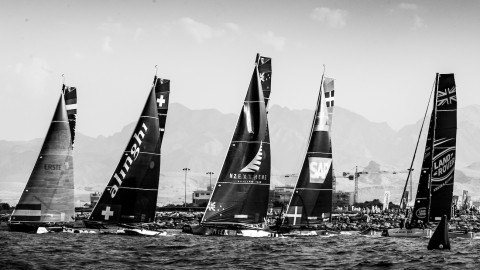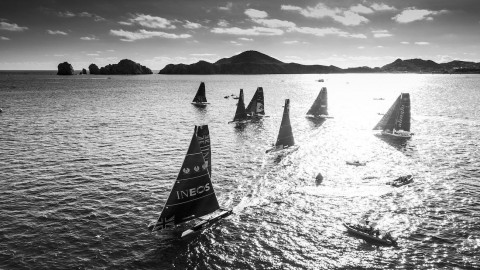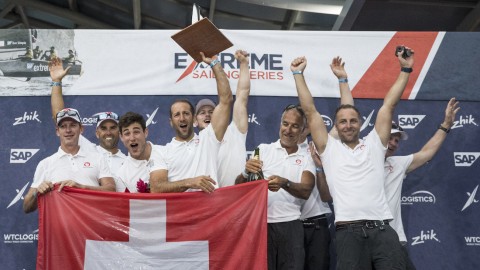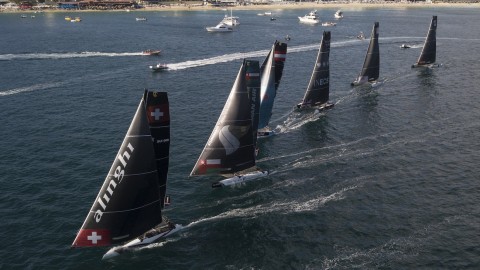The fine art of being Race Director
While the fleet of GC32s fly around a racecourse set metres from the shore to the delight of thousands of onlookers, behind the scenes there is an expert team making it all happen seamlessly. This team is led by Extreme Sailing Series™ Race Director, John Craig.
Thursday 25th May 2017

While the fleet of GC32s fly around a racecourse set metres from the shore to the delight of thousands of onlookers, behind the scenes there is an expert team making it all happen seamlessly. This team is led by Extreme Sailing Series™ Race Director, John Craig.
Craig has had a varied career in sailing, ranging from coaching the Canadian Olympic team to his role as Principal Race Officer at the legendary 34th America’s Cup. It is a diverse CV that perfectly qualifies him to run one of the tightest and fastest inshore sailing circuits around.
Craig’s role requires him to set racecourses for a fleet of hydro-foiling catamarans, capable of reaching speeds of up to 39 knots (45mph), in anything from a choppy coastal stadium to a tidal river surrounded by concrete walls. The Series visits eight venues over a season, each delivering a unique set of conditions entirely different from the next.
He must keep the sailors happy by laying fair but challenging courses, keep the spectators happy by bringing the action close to the shore, give the guests and media the best on-the-water experience, fit his racing around the live TV broadcast windows, and make sure that everything is done safely.
So how does he do it?
Sailing is one of very few sports that is entirely dependent on Mother Nature playing ball, and the first thing on Craig’s list each morning is to establish what conditions he can expect out on the racecourse.
“The weather is such a big part of it. The Series has its own weather man that gives us our forecast. But you’ll see me in the morning going around talking to the different teams to find out what they have, and then I blend it all together to try to get the most accurate prediction,” said Craig, who took on the role of Race Director at the beginning of the 2017 season.
To the untrained eye, it may appear that there is nothing particularly difficult about placing the brightly coloured inflatable buoys that are dotted across the on-the-water stadium and mark out the racecourse. In reality there is a science to it and setting the perfect course is an art.
“Determining which start you’re going to do and what the breeze is going to do is the starting point. Then typically you anchor one mark and build a course around that one mark so the gates and everything rotate around it,” explained Craig.
“Next you look at the length of the course and what you can do to make sure it’s not just a parade for one boat out in front. There needs to be passing lanes to allow the opportunity to overtake,” he continued.
A race in the Extreme Sailing Series will start in one of two ways; either with a reaching start, where the wind is parallel to the start line, or a windward start, where the wind is perpendicular to the start line.
“A reaching start, with the number of boats we have in light air, can be a challenge to execute. When it’s too windy, and we have waves and gusts of wind causing acceleration and deceleration of the boats, it can become too dangerous to do a reaching start as you are creating a situation where you can bring the boats together at high speeds,” said Craig.
“Windward starts are typically safer as the boat’s acceleration and deceleration is more controlled. These type of starts work pretty well in the light stuff, and in the breeze you definitely have to use them,” he added.
For the signature stadium races in the Extreme Sailing Series, the boats race on a windward-leeward course. If there is a windward start, the fleet will be set off from a start line and head straight upwind to the windward gate (marked by white buoys). If there is a reaching start, the fleet will first complete a reaching leg and then head around a red inflatable mark before sailing downwind to the leeward gate (marked by yellow buoys).
The boats will go through the first gate and around either of the two marks and then sail back the way they came towards the opposite end of the racecourse where there is another gate. This ‘sausage’ shape can be repeated multiple times. Before crossing the finish line the fleet will usually complete one last reaching leg.

Diagram of an Extreme Sailing Series™ windward-leeward stadium racecourse with a reaching start
As sailing has been revolutionised by the advent of foils, with boats getting faster and racing closer to the shore, so too has Craig’s job:
“As a result of the development of foiling boats and the higher speeds we’ve created new rules which we’re in the process of working with World Sailing to put in place - fast boat rules that would be used by all foiling boats. I really enjoy that part of the job, it’s interesting and will lead to safer more competitive racing,” said Craig.
Despite the many challenges – or perhaps because of them - Craig loves his job: “My favourite part is actually dealing with the athletes, interfacing with them is all part of the game. I always like talking to the sailors and I always encourage them to give me feedback, whether it’s good or bad, and I’ve known a lot of them for a long time.
“And then just running races; if you can run some quality races and have a good day and knock it out of the park then it’s great,” said Craig.




